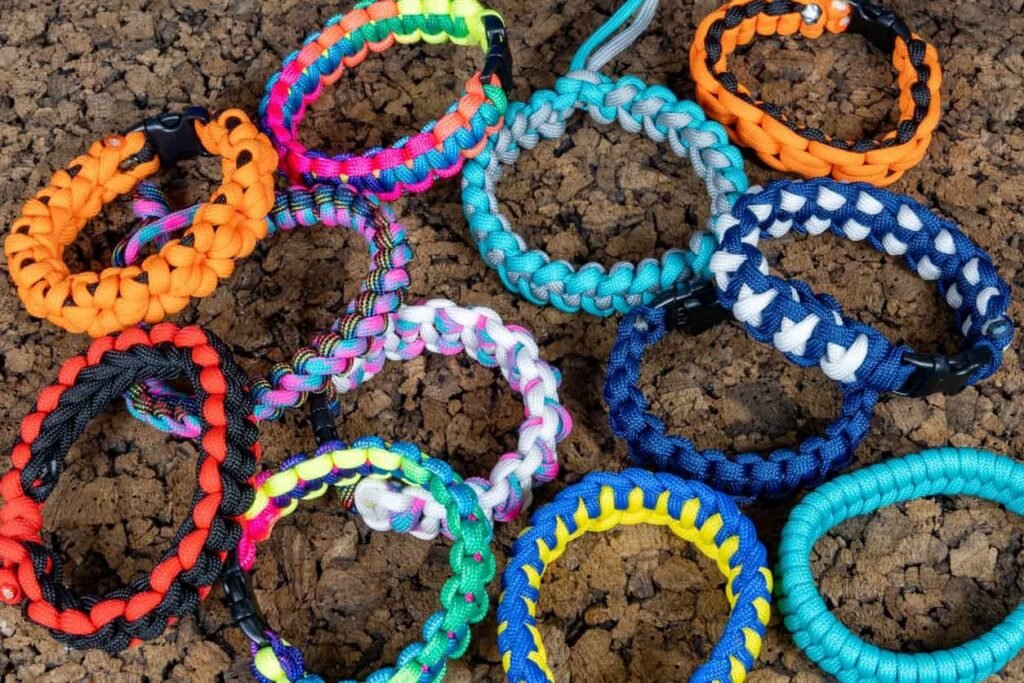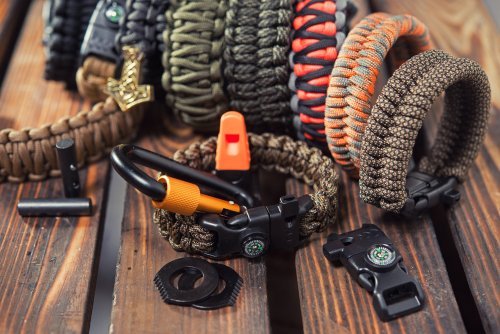Paracord bracelets are really popular because they look cool, are fun to wear, and can even help in emergencies. Made from strong rope called paracord, these bracelets are great for outdoor adventures or just as a stylish accessory. Many people wear their paracord bracelets all the time and don’t want to take them off—even when they shower. But is it okay to wear your paracord bracelet in the shower? Will water ruin it, or will it be just fine?
In this article, we’ll talk about what paracord is made of, how it handles water, and what you should do to take care of your bracelet if you wear it in the shower. By the end, you’ll know whether it’s safe to keep your bracelet on when you hop in for a shower!
Understanding Paracord Material and Water Resistance
Paracord bracelets are made from a special material called paracord, short for parachute cord. This strong, flexible rope was originally made for the military, and it’s known for being tough and reliable. But what happens when paracord gets wet? Let’s explore what paracord is made of and how well it can handle water.
1. What Is Paracord Made Of?
Paracord is made from a material called nylon, which is a type of synthetic fiber. Nylon is popular for making ropes, fabrics, and even fishing lines because it has some amazing qualities.
- Durability:Nylon is very strong and can hold a lot of weight without breaking. This is why paracord is used for survival tools and heavy-duty tasks.
- Flexibility:Paracord is easy to bend, twist, and tie into different shapes, which makes it perfect for weaving into bracelets.
- Water Resistance:Nylon doesn’t absorb much water, so it stays strong even if it gets wet. This is why paracord is a great choice for outdoor use, where it might get exposed to rain or water.
2. How Does Paracord Handle Water?
Because nylon is water-resistant, paracord can handle getting wet without being damaged. This makes it safe to wear your paracord bracelet in the shower or even while swimming. However, there are a few things to keep in mind:
- Maintains Strength:When paracord gets wet, it doesn’t lose its strength. This means it will still work as a strong rope, even after being soaked.
- Quick Drying:Paracord dries fairly quickly compared to materials like cotton or leather. This helps prevent problems like mildew or a bad smell if you let it dry properly after it gets wet.
- Water-Friendly Uses:Paracord’s ability to handle water is one reason it’s often used for boating, fishing, and camping. It won’t weaken or fall apart if it gets splashed or submerged.
3. Does Water Affect the Bracelet Over Time?
While paracord itself is very durable, wearing your bracelet in water every day—like in the shower—can cause minor wear and tear over time.
- Fraying:The outer layer of the paracord might start to fray slightly if it’s exposed to water frequently. This doesn’t make the bracelet unusable, but it might look less neat after a while.
- Texture Changes:Repeated exposure to water and soap might make the cord feel a bit stiffer or rougher. This happens because soap residue can build up on the nylon fibers.
- Accessories and Clasps:If your bracelet has metal clasps or charms, water might cause these parts to rust or tarnish unless they’re made from stainless steel or another water-resistant material.
4. Why Is Paracord a Great Water-Resistant Material?
Nylon’s water-resistant qualities make paracord a top choice for people who love outdoor activities or need a reliable rope for emergencies.
- Perfect for All Weather:Whether it’s raining or sunny, paracord holds up well. It won’t get ruined in the rain or weaken if it gets soaked.
- Used in Water-Heavy Environments:Paracord is often used in marine settings, like on boats or near water, because it can stay strong and reliable even when wet.
- Versatile and Long-Lasting:As long as you care for your bracelet by drying it properly, it can last a long time, even with regular exposure to water.

Effects of Showering on a Paracord Bracelet
Paracord bracelets are strong and water-resistant, which means they can handle getting wet without losing their strength. But if you wear your paracord bracelet in the shower every day, you might notice some small changes over time. Let’s explore what happens to your bracelet when it’s exposed to water, soap, and daily shower routines.
1. The Bracelet’s Strength and Durability
One of the best things about paracord is that it stays strong even when it’s wet. Showering with your paracord bracelet doesn’t weaken its overall durability, but there are some small effects to consider:
- Strength Stays the Same:Even after being soaked in water, paracord keeps its ability to hold weight and handle tough tasks. This means your bracelet will still work as a reliable tool in emergencies.
- Minor Wear Over Time:While the cord itself won’t break, daily exposure to water might cause the surface of the bracelet to wear down slightly. For example, the outer layer could start to fray or look a bit fuzzy after repeated use in wet conditions.
2. Changes to the Bracelet’s Appearance
Frequent exposure to water and soap can affect how your bracelet looks. Here are some changes you might notice:
- Fraying of the Cord:Over time, the constant contact with water and rubbing against your skin or soap can cause the ends of the cord or some parts of the weave to fray. This doesn’t affect how the bracelet works, but it might make it look less tidy.
- Fading Colors:If your paracord bracelet is brightly colored, the dyes might start to fade with frequent water exposure, especially if you use hot water or soap that contains harsh chemicals. This is more noticeable with neon or pastel colors.
- Build-Up of Soap Residue:Soap can leave a residue on the nylon fibers, which might make the bracelet feel stiffer or look dull. This is easy to fix with proper cleaning and drying.
3. Effects on Accessories and Clasps
If your paracord bracelet has added accessories, such as metal clasps or charms, these parts might be affected differently by showering:
- Metal Clasps or Charms:Some metals, like stainless steel, are water-resistant and won’t rust. However, other metals, like iron or cheap alloys, might tarnish or corrode if exposed to water often. If your bracelet includes these materials, it’s a good idea to dry it carefully after each shower.
- Plastic Buckles:Plastic buckles are generally safe in the shower and won’t be damaged by water. However, soap residue can build up on them, so occasional cleaning is helpful.
- Decorative Beads or Fabric Wraps:If your bracelet has extra decorations like beads or fabric wraps, these might not handle water as well as the paracord itself. Beads might lose their shine, and fabric could become worn or discolored.
Care Tips for Paracord Bracelets After Showering
Paracord bracelets are tough enough to handle getting wet, but to keep them looking good and working well, it’s important to take care of them. Showering with your bracelet can expose it to water, soap, and shampoo, which might affect its appearance and texture over time. Luckily, with just a little care, you can make sure your bracelet stays in great shape. Here are some easy tips for caring for your paracord bracelet after it gets wet.
1. Dry the Bracelet Properly
One of the most important things to do after your bracelet gets wet is to dry it thoroughly. Leaving it damp can cause bad smells or mildew to grow, even if the paracord itself is water-resistant.
- Pat It Dry:Use a soft towel to gently pat your bracelet and remove as much water as possible. Make sure to focus on the weaves and knots where water might collect.
- Air Dry in a Cool Place:Let the bracelet air dry completely before putting it back on. Place it in a cool, shaded area with good airflow. Avoid direct sunlight, as this might cause the colors to fade over time.
- Avoid Heat Sources:Don’t use a hairdryer or place the bracelet near a heater to speed up drying. High heat can damage the nylon and make the bracelet stiff or brittle.
2. Rinse Off Soap Residue
Soap and shampoo from the shower can build up on your paracord bracelet over time, making it look dull or feel stiff. Rinsing your bracelet properly can prevent this problem.
- Rinse with Clean Water:After your shower, rinse the bracelet thoroughly under clean, running water to remove any soap or shampoo. This helps keep the nylon fibers clean and flexible.
- Check for Hidden Residue:Pay close attention to areas with tight knots or weaves, as soap can get trapped there. Use your fingers to gently rub these areas and ensure all residue is washed away.
3. Wash Your Bracelet Occasionally
Even with regular rinsing, your bracelet might need a deeper clean every now and then to stay fresh and free of dirt or odors.
- Use Mild Soap:Fill a small bowl with warm water and add a drop of mild soap or detergent. Gently soak the bracelet for a few minutes, then use your fingers or a soft brush to clean it.
- Rinse Thoroughly:After washing, rinse the bracelet under running water until all the soap is gone. Be sure to remove any leftover detergent, as this can make the bracelet feel sticky or stiff.
- Dry Completely:After cleaning, pat the bracelet dry with a towel and let it air dry completely, as described above.
4. Handle Accessories with Care
If your bracelet has extra parts, like metal clasps or decorative beads, these might need extra attention to keep them looking good.
- Prevent Rust on Metal Parts:If your bracelet has metal clasps or charms, dry them carefully after each shower to prevent rust or tarnishing. Use a soft cloth to gently polish the metal.
- Check for Damage:Inspect the accessories regularly to make sure they’re not loosening or corroding. If you notice any wear, you can replace these parts to keep your bracelet looking great.
- Avoid Harsh Chemicals:Don’t use strong cleaning chemicals on metal or decorative parts, as this could damage them. Stick to mild soap and water instead.
5. Inspect for Wear and Tear
Taking a moment to look over your bracelet can help you spot any problems early, like fraying or loosening knots.
- Look for Frayed Edges:Check the ends of the paracord and any exposed sections for fraying. If you see frayed edges, you can use a lighter to melt them slightly and seal them again.
- Check the Weave Tightness:Make sure the knots and weave are still tight and secure. If they’ve loosened, you might need to tighten or reweave parts of the bracelet.
- Examine Clasps and Buckles:If your bracelet has a buckle, make sure it’s still working properly and hasn’t cracked or weakened. This ensures your bracelet stays securely on your wrist.
Alternatives for Long-Term Wear
Paracord bracelets are tough and practical, but wearing them every day in the shower or while doing other water-based activities can make them wear out faster. If you want your bracelet to last a long time, there are a few alternatives to think about. These options can help protect your bracelet while still letting you enjoy wearing it when it matters most.
1. Rotating Between Two Bracelets
If you love your paracord bracelet and wear it all the time, having a second one can be a smart idea. This gives you a backup for different situations.
- Shower-Friendly Bracelet:Choose one bracelet to wear during activities where it might get wet, like in the shower or at the pool. This bracelet can be simpler and without extra accessories that might get damaged by water.
- Dry-Use Bracelet:Save your fancier bracelet for dry activities or special occasions. This helps keep it in better condition for longer and prevents wear and tear from daily exposure to water.
- Take Turns Wearing Them:Rotating bracelets means you’re not putting constant stress on just one. While one bracelet dries out, you can wear the other one, giving both a longer lifespan.
2. Choosing Waterproof Materials
If you don’t want to worry about your bracelet getting wet, you can look for paracord bracelets made with waterproof materials.
- Stainless Steel Clasps:If your current bracelet has a metal clasp that rusts or tarnishes, replace it with a clasp made of stainless steel. Stainless steel is resistant to water and won’t corrode over time.
- Plastic or Resin Buckles:Plastic buckles are another great option for a waterproof bracelet. They don’t rust and are lightweight, making them perfect for daily use, even in the shower.
- Specially Treated Paracord:Some paracord is treated with coatings that make it extra resistant to water and stains. This type of cord might be worth considering if you wear your bracelet in wet conditions often.
3. Making a Bracelet Specifically for Water Activities
If you’re someone who loves swimming, showering, or being in the water, you can make or buy a water-specific bracelet that’s designed for those activities.
- Simpler Designs:A water-friendly bracelet can have a basic weave and no extra decorations. This makes it easier to clean and maintain.
- Durable Materials:Use paracord and buckles designed to handle constant water exposure. Look for products labeled as waterproof or designed for outdoor use.
- Leave Fancy Accessories Off:Avoid adding beads, charms, or non-waterproof materials to this bracelet. Keeping it simple helps it last longer in wet conditions.
4. Removing the Bracelet for Water-Based Activities
If you want your paracord bracelet to stay in perfect condition, you can choose to take it off during activities where it might get wet, like showers or swimming.
- Save It for Dry Wear:Removing your bracelet before showering or swimming is the easiest way to prevent fraying, fading, or other damage. This ensures it stays clean and looks great for a long time.
- Store It Safely:When you take off your bracelet, store it in a safe, dry place where it won’t get lost. A small box or drawer works well, and it’s easy to grab your bracelet when you’re ready to wear it again.
- Less Maintenance Required:By keeping your bracelet away from water, you won’t need to wash or dry it as often, which saves time and effort.
5. Switching to a Necklace or Keychain
If you want to keep paracord with you all the time but don’t want to worry about wearing it on your wrist, you can try turning it into a necklace or keychain.
- Necklace Option:A paracord necklace can hold just as much cord as a bracelet, and it’s less likely to get soaked in water if you wear it under your shirt.
- Keychain or Zipper Pull:Another alternative is to use paracord to make a keychain or attach it to your bag as a zipper pull. This way, you’ll always have paracord with you, but it won’t be affected by daily wear and tear.
- Keeps the Cord Accessible:Whether on your keys or your bag, a paracord keychain keeps the cord easy to access for emergencies or other uses.

Conclusion
Paracord is made from durable nylon, which is water-resistant and strong enough to handle getting wet without losing its functionality. However, daily exposure to water and soap can lead to minor changes over time, like fraying, stiffness, or faded colors. To keep your bracelet in good shape, it’s important to rinse off soap residue, dry it thoroughly, and check for wear and tear. If you want your bracelet to last even longer, consider rotating it with another bracelet or removing it during showers. With proper care, your paracord bracelet can stay stylish, useful, and ready for all your adventures—whether you’re in the shower or out in the world!

